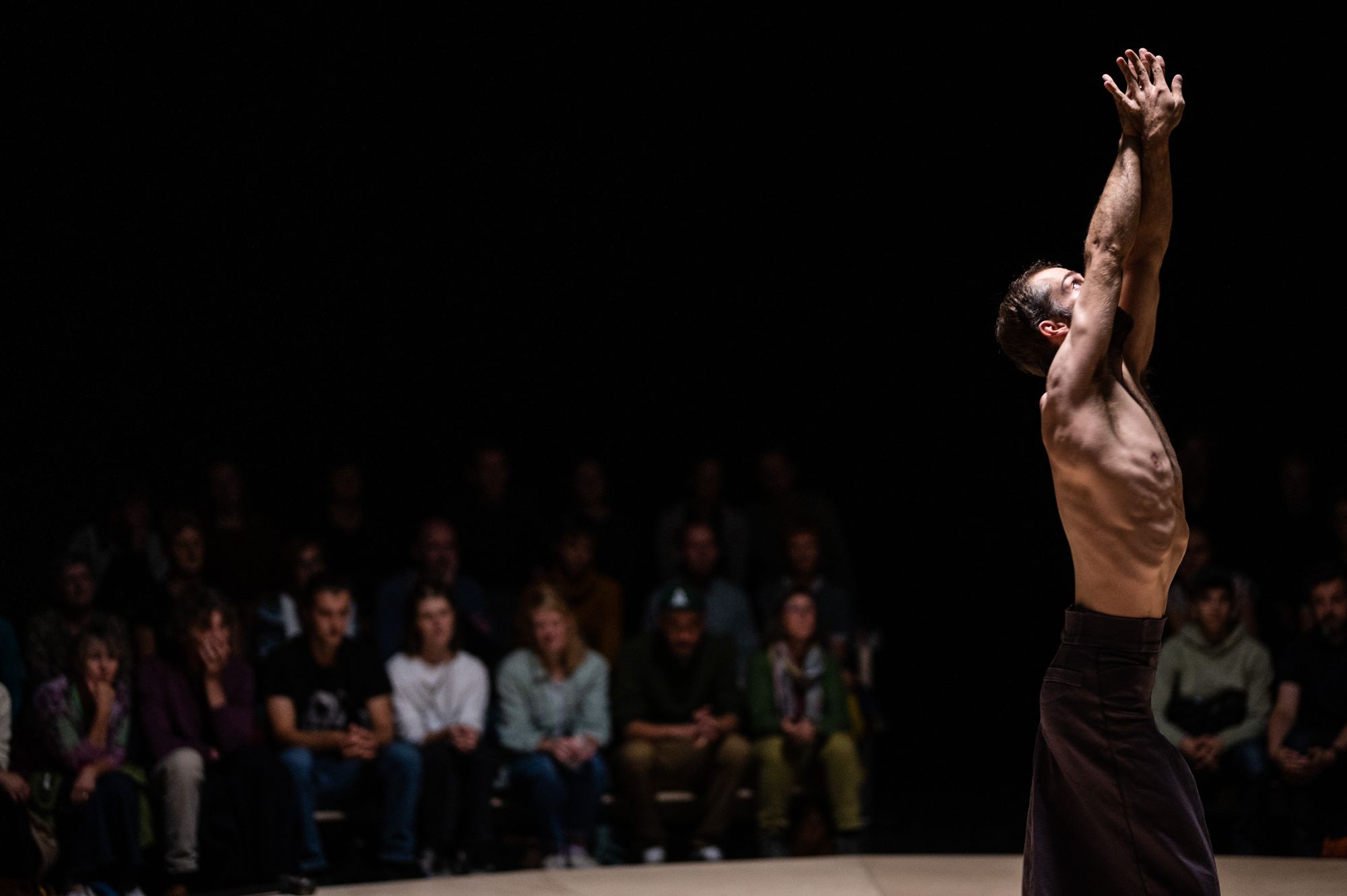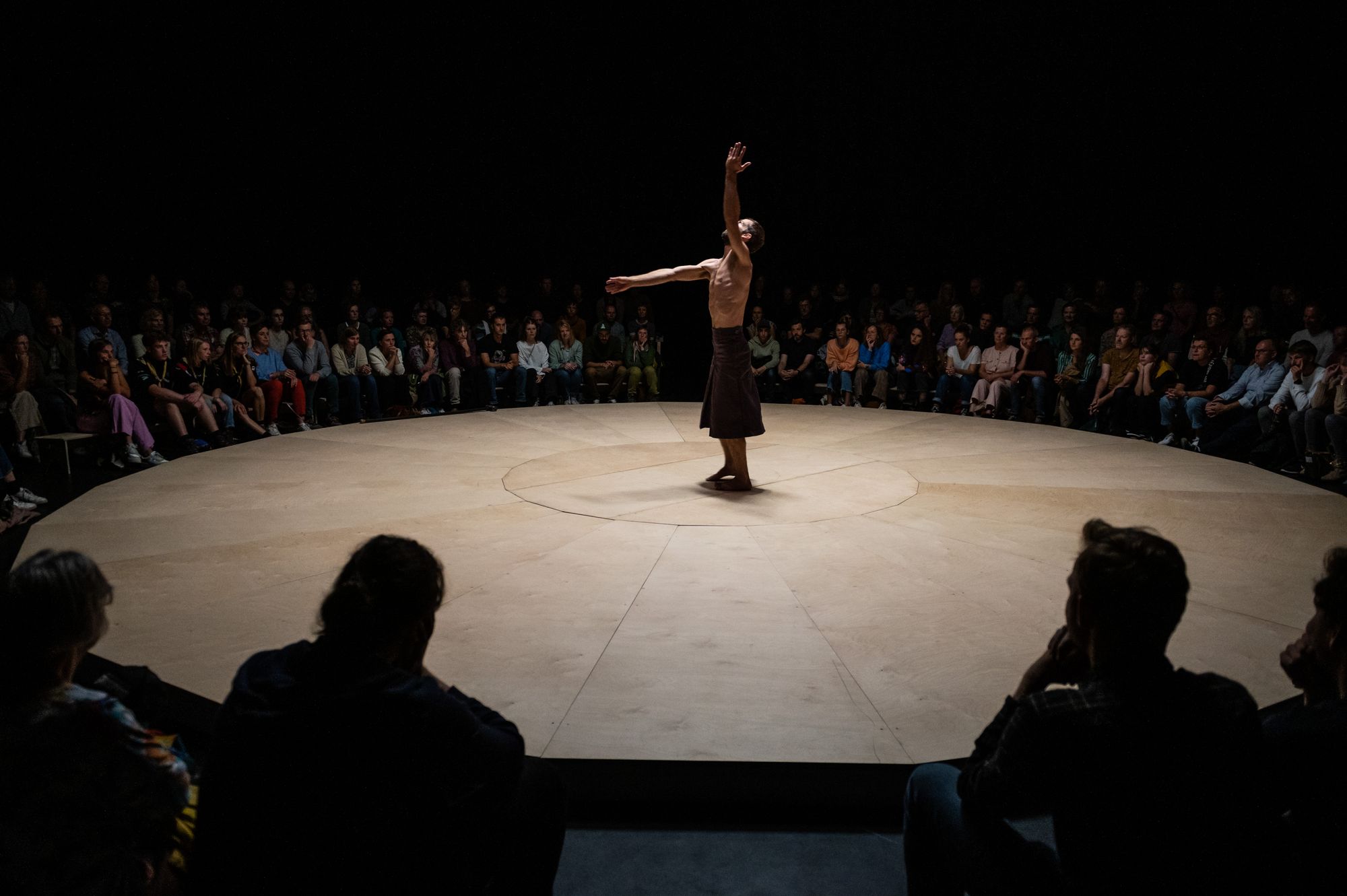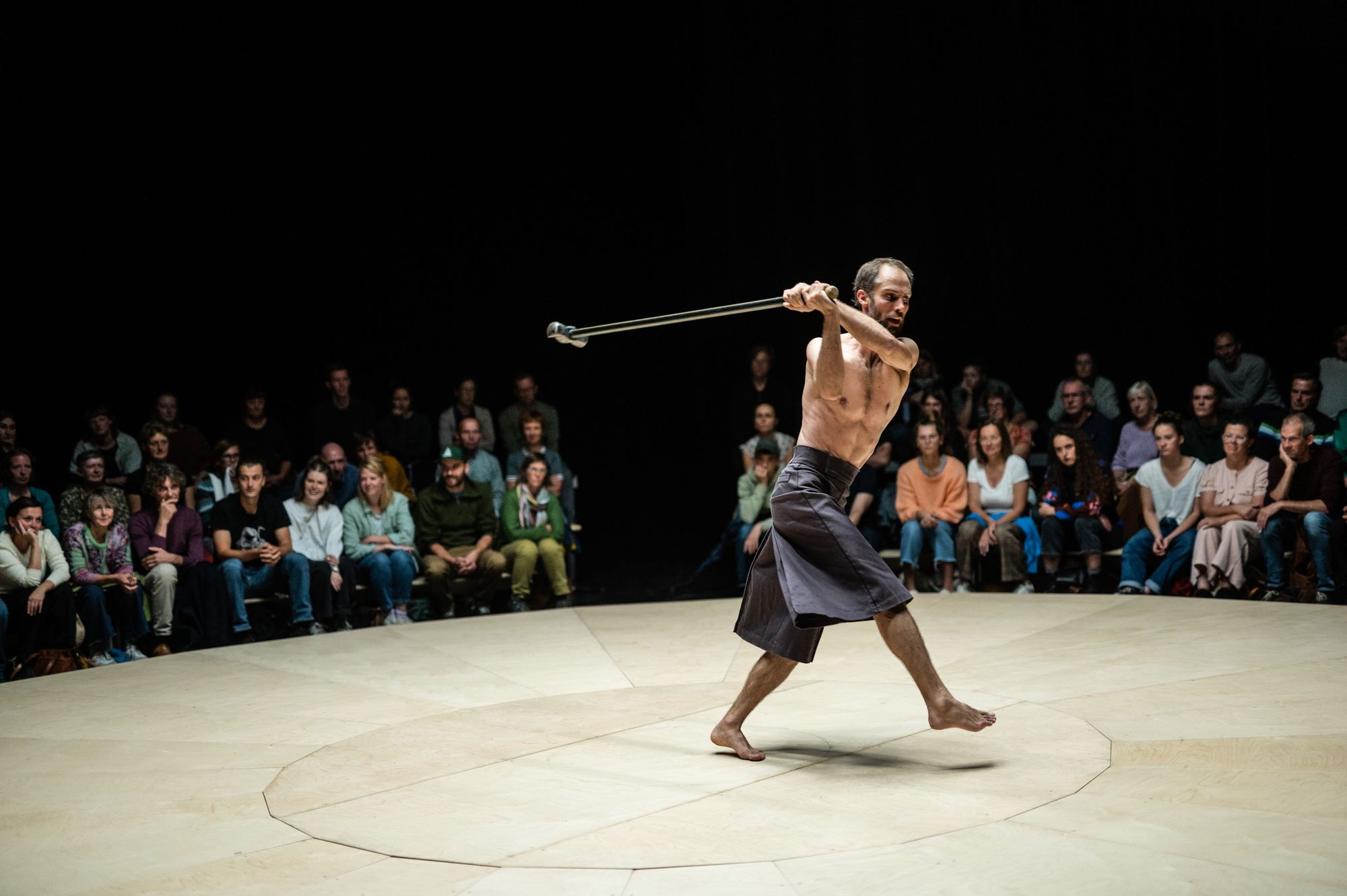In a Genre-Bending Epic, Objects Take on a Life of their Own

In VanThorhout, his first solo creation in nearly a decade, Alexander Vantournhout rewrites the limits of his body – this time, with a renewed restlessness about the meaning of masculinity, manipulation, and weapons.
Now I know what it is like to stare down a heavy weight hurtling in an orbit at eye-level, to fear that centrifugal force could carry it – should it slip out of that orbit – to collide, catastrophically, with my head.
This constituted one of several climactic moments in Alexander Vantournhout’s newest solo work, VanThorhout, which he presented at the CircusDanceFestival in Cologne, Germany at the end of May. The weight was a custom-designed sledgehammer, a reinterpretation of the Norse god Thor’s hammer and its promise of protection and honor. By roughly the middle of the 50-minute performance, Alexander was holding its handle in one hand while spinning, faster and faster, at the center of the round stage.
Needless to say, no one was hurt. The real possibility of danger, Alexander assured me when we spoke afterwards, was negligible: he estimated he was using at most 40 percent of his strength to keep the prop from slipping out of his grip. And yet, the tension that hung in the air was palpable. With a soundscape so bare – built predominantly on the rhythmic thudding of Alexander’s feet on the hollow, wooden floor – I could hear clearly the collective, sharp inhalations among the audience.
Alexander, 34, is the founder and director of the Belgian company not standing, which over the past decade has earned a reputation for choreographic works that straddle circus and dance. Over the arch of his repertoire, he and the company members have deployed their extreme athleticism in service of an enduring inquiry into the ontological relationship between humans and objects. Object manipulation, their research demonstrates, is never unidirectional. Rather, it creates an entangled system in which object and human mutually affect one another. Regardless of original impetus, both parts of the assemblage have their own momentum and inertia (sometimes aligning, sometimes diverging) that play into the unfolding action. The lines between who – and what – is in control are blurred.

For this present creation, conceived of during the early months of Putin’s war in Ukraine, Alexander turned his attention to weapons. It would be reductive to view Alexander's protagonist solely as an archetype of masculine dominance or war-mongering, and yet underneath the entire piece lurks a fear of history’s violent propulsion, the destructive potential of this power in the hands of a lone man. To witness such peril rendered concrete and immediate as kinetic potential brought twinges of recognition buried within the intoxicating rush of adrenaline.
In the flying sledgehammer, I saw reflected my own emotional dissonance under pressure: On one hand, my incredulity, as a spectator, at having been subjected to this risk. On the other, my pride in not flinching, in staying cool, at least externally. Several individuals stood up and backed away – an admirable exercise of choice (though the choice hadn’t occurred to me).
This brief segment was well-earned, built up to slowly and carefully. The piece began with Alexander guiding himself into a trance-like spin without a prop, his arms held out in a sculptural configuration, reminiscent of a whirling dervish. The position of his arms continually evolved in a spiral blossoming, delicate at first, until the contained movements digressed into choppy flailing.
Spirals are a motif embedded in much of Alexander’s composition, as are a handful of other concepts borrowed from architecture and the natural world. “We are full of spirals,” he explained. “It is how the body is made.” The piece celebrates this, while furthering Alexander’s ongoing quest to measure his body – the proportion of his limbs, his height – against other bodies, human or otherwise. Here is another theme that runs through his repertoire, and which is wonderfully manifest in VanThorhout: an anxiousness to pin down, catalog, test, play with, and make sense of the body’s capacities to be relational as a physical structure.
The handle of the hammer, as opposed to the famously short handle on Thor’s hammer, was roughly equivalent to Alexander’s arm span. This fact became important when he slung the prop over his shoulder and let it wrap around his body. It was here, remarkably, that the handle was revealed to be bendable, and thus mostly ineffectual as a tool or weapon.

The object is “polymorphic” (another term Alexander often returns to), which is to say that it changed shape without changing material. The transformation mirrored that of the protagonist. Drained of (at least some of) its potency as a symbol of male virility and heroism, the limp hammer was nonetheless beautiful. It showed itself to be, in fact, more accommodating to that sought-after relationality. The audience laughed, not because the hammer or the man was pathetic, but because the tension in the room had been supplanted by a newfound flexibility. None of this did anything to diffuse the struggle playing out in the entanglement between man and object, nor its rigor and stakes.
VanThorhout is a sensitive, mesmerizing, and psychologically multivalent work. For all the war-like imagery I allude to, I also felt moments of lightness, which layered upon (rather than replaced) the many affective states that the work produced.
I felt childlike delight when Alexander swapped out the hammer in favor of a white flag on an even longer pole. At the end of the performance, he swept it over the audience in the same circular fashion. Whether this was an offering or, more cynically, a resolution forced upon us remains a contradiction. I use the word “childlike” advisedly because I and many others in attendance instinctively reached up to touch the flag as it passed overhead, and this reciprocal reaching for contact – between us, the familiar symbol – was wholesome, poignant, and possibly naive.

